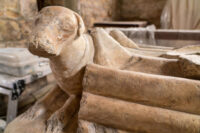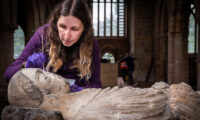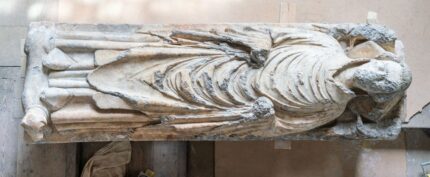A 14th century alabaster funerary effigy of a cleric defaced and hidden during Henry VIII’s Dissolution of the Monasteries has been unveiled in the church of St. Wilfrid’s in Barrow-upon-Trent, Derbyshire. It has been tentatively identified as the effigy of parish priest John de Belton who died around 1350. If the identification is correct, this is the oldest existing alabaster effigy of a priest in Britain.
The priest’s face is chipped away, likely a deliberate act. His hands, which were originally joined in prayer over his chest, have been cut off, as have the heads of the angels that cradle each side of his head. A small dog lies at his feet. The quality of the sculpture — the depth of the carved drapery — is exceptionally high.
Alabaster was an expensive material that was highly prized for funerary effigies because it of how artfully details like garment folds and armor can be rendered in the soft freshly-quarried stone. Once it has been exposed to the air, it hardens and can be polished to a high gloss. The earliest ones in England date to around 1330, but the fashion for alabaster effigies really took off after around 1370. Only 34 effigies of 339 recorded in England and Wales are known to date to before 1370.
 The translucent luster of polished alabaster provided a realistic skin-tone effect, but much of the rest of the effigies were painted, physical features like hair and eyes in natural tones, garments, armature and heraldry in bright colors. The most high-status monuments were also gilded. The polychromy and gilding rarely survive today, especially on effigies that are still in churches instead of in collections and museums. The St. Wilfrid effigy has more surviving paint and gold than any other known effigies from the early period.
The translucent luster of polished alabaster provided a realistic skin-tone effect, but much of the rest of the effigies were painted, physical features like hair and eyes in natural tones, garments, armature and heraldry in bright colors. The most high-status monuments were also gilded. The polychromy and gilding rarely survive today, especially on effigies that are still in churches instead of in collections and museums. The St. Wilfrid effigy has more surviving paint and gold than any other known effigies from the early period.
“He would have been a very bright, blingy type of statue when he was first made – so far, the conservators have found dark red, bright blue, black and green paint as well as gold,” said Anne Heathcote, the church warden of St Wilfrid’s in Barrow-upon-Trent, who made the discovery. “He is wearing priest’s robes, which have been very finely sculpted by someone who was obviously a master sculptor.”
St Wilfrid’s is an Anglo-Saxon church built around 800 A.D. After the Norman Conquest, Barrow-upon-Trent, its parish church and much of Derbyshire were granted by the new king to Norman lord Henry de Ferrers. In 1165, Ferrer’s liegeman Robert de Bakepuiz donated the church to the Order of Knights of the Hospital of Saint John of Jerusalem, aka the Knights Hospitaller. Donating properties to the Knights Hospitaller was increasingly fashionable among European nobility who wanted to be seen to be contributing to the support of the Crusades. By the 15th century, the Knights were the largest landowners in England.
While serving the parish in 1348, De Belton is thought to have lost his life to the Black Death. “We have two Black Death pits in the churchyard and because it’s a Knights Hospitaller church, we think that the Hospitallers looked after plague victims and buried them. That was part of their job.”
After the Reformation, the effigy was hidden behind box pews and then, in the 18th century, a pipe organ.
Its existence was documented in the 19th century, but even then it was not appreciated for its early age and sculptural quality. Anne Heathcote has known it was there since she was a child clambering around behind the organ under her father’s tenure as church warden. It was never in public view, however, and was largely forgotten until the Church Monuments Society contacted Heathcote to ask about the effigy four years ago. Even defaced and caked in dirt, the experts could tell it was a nationally significant piece because of its fine carving and the surviving polychrome paint.
 The church has been renovated and converted into a community center. The effigy has now been cleaned and conserved and taken out from behind the organ. It is encased in protective glass and a mirror has been mounted over it so visitors can get a clear view of the intricate carving.
The church has been renovated and converted into a community center. The effigy has now been cleaned and conserved and taken out from behind the organ. It is encased in protective glass and a mirror has been mounted over it so visitors can get a clear view of the intricate carving.

and not once did you mention the forever faithful carved dog.
Second para: “A small dog lies at his feet. “.